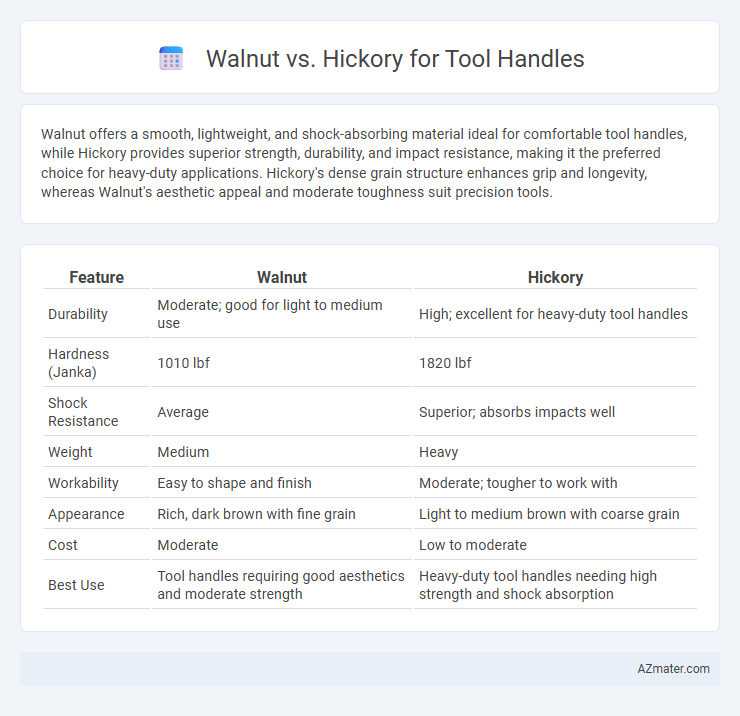Walnut offers a smooth, lightweight, and shock-absorbing material ideal for comfortable tool handles, while Hickory provides superior strength, durability, and impact resistance, making it the preferred choice for heavy-duty applications. Hickory's dense grain structure enhances grip and longevity, whereas Walnut's aesthetic appeal and moderate toughness suit precision tools.
Table of Comparison
| Feature | Walnut | Hickory |
|---|---|---|
| Durability | Moderate; good for light to medium use | High; excellent for heavy-duty tool handles |
| Hardness (Janka) | 1010 lbf | 1820 lbf |
| Shock Resistance | Average | Superior; absorbs impacts well |
| Weight | Medium | Heavy |
| Workability | Easy to shape and finish | Moderate; tougher to work with |
| Appearance | Rich, dark brown with fine grain | Light to medium brown with coarse grain |
| Cost | Moderate | Low to moderate |
| Best Use | Tool handles requiring good aesthetics and moderate strength | Heavy-duty tool handles needing high strength and shock absorption |
Overview of Walnut and Hickory for Tool Handles
Walnut tool handles are valued for their moderate strength, smooth grain, and attractive dark color, making them suitable for lightweight or precision tools. Hickory offers superior toughness, shock resistance, and durability, often preferred for heavy-duty tool handles like hammers and axes due to its high impact absorption. Both woods provide excellent workability, but hickory's dense, fibrous structure gives it an edge in resilience and longevity under rigorous use.
Wood Hardness and Durability Comparison
Walnut offers moderate hardness with a Janka rating around 1,010 lbf, making it comfortable and shock-absorbent for tool handles, but less resistant to heavy wear compared to hickory. Hickory boasts a higher Janka hardness of about 1,820 lbf, providing superior durability, impact resistance, and longevity under rigorous use. For tool handles requiring strength and toughness, hickory outperforms walnut in hardness and durability, ensuring better performance and lifespan in demanding conditions.
Shock Absorption: Walnut vs Hickory
Walnut and hickory differ significantly in shock absorption properties for tool handles, with hickory offering superior resilience due to its high density and strong fibers that absorb impact effectively. Walnut, while aesthetically pleasing and moderately durable, has lower shock absorption, making it less ideal for heavy-duty tools where vibration reduction is critical. Hickory's excellent shock absorption enhances user comfort and control, extending tool lifespan by minimizing wear from repeated stress.
Weight and Balance Differences
Walnut tool handles offer a lighter weight, typically around 38-45 lbs per cubic foot, providing easier maneuverability and less fatigue during prolonged use. Hickory, denser at approximately 50-55 lbs per cubic foot, delivers superior strength and impact resistance, contributing to enhanced durability and control. The balance of walnut handles favors quicker, agile movements, while hickory handles provide a steadier, more powerful swing due to their weight distribution.
Workability and Shaping Ease
Walnut offers excellent workability for tool handles due to its moderate density and fine grain, allowing smooth shaping with hand tools and machines. Hickory, known for its exceptional toughness and hardness, requires more effort to shape but provides superior durability under heavy use. Both woods are popular, yet walnut is favored for intricate detailing while hickory excels in impact resistance and longevity.
Resistance to Wear and Splintering
Walnut and hickory both offer strong resistance to wear and splintering, but hickory is generally superior due to its exceptional hardness and shock-absorbing properties. Hickory's dense grain structure provides enhanced durability for high-impact tool handles, reducing the risk of splintering under heavy use. Walnut, while durable and less prone to splintering than softer woods, is softer and more prone to surface wear over extended use compared to hickory.
Cost and Availability
Walnut and hickory differ significantly in cost and availability for tool handles, with hickory generally being more affordable and easier to source due to its widespread growth in North America. Walnut typically commands a higher price because of its slower growth rate and premium hardwood status, resulting in limited availability for large-scale tool handle production. Hickory's abundant supply and favorable strength-to-cost ratio make it the preferred choice for durable, cost-effective tool handles.
Traditional and Modern Uses
Walnut and Hickory are preferred woods for tool handles due to their durability and shock resistance, with Hickory traditionally favored for heavy-duty tools like hammers and axes because of its superior strength and flexibility. Walnut, known for its fine grain and smooth finish, is commonly used in more decorative or precision tool handles where aesthetics and comfort are prioritized. Modern applications often blend these woods, using Hickory for impact tools and Walnut for ergonomic or custom-designed handles, balancing performance and appearance.
Aesthetic Appeal: Grain and Color
Walnut offers a rich, dark brown color with a straight, fine grain that provides a smooth, elegant aesthetic ideal for refined tool handles. Hickory features a lighter, creamy to reddish-brown hue with a more pronounced, wavy grain pattern that imparts a rugged, rustic appearance. The choice between walnut and hickory hinges on the desired visual impact, with walnut delivering sophistication and hickory emphasizing natural character.
Best Uses for Each Wood in Tool Handles
Walnut offers excellent shock absorption and a smooth finish, making it ideal for premium tool handles used in gardening and woodworking, where comfort and aesthetics are valued. Hickory provides superior strength, toughness, and resistance to impact, making it the top choice for heavy-duty tool handles like hammers, axes, and mauls that require durability under intense stress. Each wood's unique grain structure and density directly influence its performance, with hickory favored for robustness and walnut selected for ergonomic, fine woodworking tools.

Infographic: Walnut vs Hickory for Tool Handle
 azmater.com
azmater.com